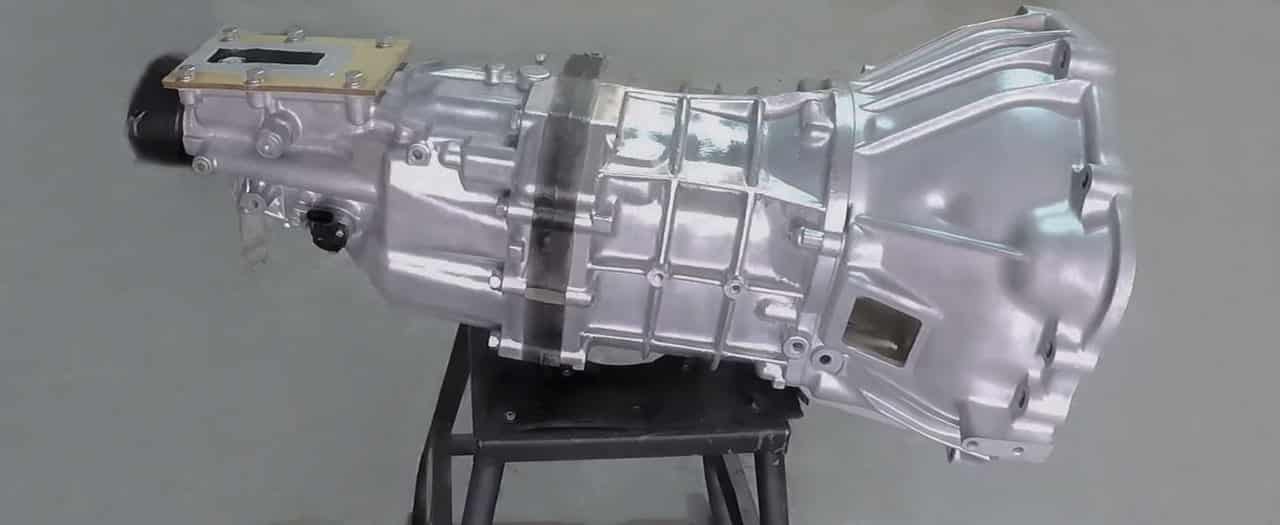People have been sticking RWD Toyota 5-speeds behind everything from suped up 1600 Ford crossflows to inline6's and V8's. Basically, Toyota gearboxes are renound for strength as well as reliabilty, ratio selection and affordability. I have seen and heard many questions regarding differences between the boxes etc. and how to tell which box you have. Having recently switched to a toyota box myself I decided to find out as much as I could.
- W58 Gearbox Oil Capacity
- Toyota W58 Transmission
- W58 Gearbox For Sale Nz
- W58 Gearbox Oil
- W58 Gearbox Strength
The Boxes
The W58 is sometimes designated as a 'close-ratio transmission'; however, in its stock form it does not meet all the criteria for a close-ratio box. Toyota engineers have shown favor to the W58 over the rest of the 'W' series by including it in so many models and even building a stronger version for higher powered applications.
- Toyota used the W55 series transmission in the 1981-1984 Celica, the W56 was used in 1984 and later Toyota pickup truck, the W58 was installed in the Supra starting in 1982. Transmission model W55, W56 and W58 units are shown in the following illustrations.
- Pure FunctionFacebook: If you’re looking for a premier.
- The steel sandwich plate has some minor internal differences, and it is believed to be slightly stronger (some wider bearings, some wider gears, slightly different gear selection mechanism, etc.). In theory the all-alloy version of the W58 should be the exact same strength as any other all-alloy W-Series transmission.
1. The Spilt-Case alloy 5 speed. 28kgs, excellent for anything up to 1600cc's. Found behind any 2T or 3T toyota engine. Strong and light but not up to really high power 4 cylinders. Great behind crossflow escorts and anglias, datsuns and MG's etc
Gear ratios: 1st 3.58:1, 2nd 2.02:1, 3rd 1.38:1. 4th 1:1 and 5th 0.86:1
2. The Steel Case Celica box. Very strong but heavy 45kgs. Can handle anything up to around 250hp. Found behind all 2 litre Celicas and old Crowns, Cressidas and Coronas.
First gear ratios vary: 3.28, 3.52 common. 3.62 and 3.00 very rare.
All have the same 0.85:1 5th.
3. Alloy Case Supra box. Very strong and light also, 35kgs. Found in most later model RWD Toyotas. Can handle upto and beyond 300hp. Four different sorts: W55, W57, W58 and W59.. pretty much in that order of rarity.
Ratios: W55: 1st 3.57:1, 2nd 2.06:1, 3rd 1.38:1, 5th 0.85:1
W57: 1st 3.28:1, 2nd 1.89:1, 3rd 1.27:1, 5th 0.85:1 W58 is the same except a taller 5th 0.78:1.
W59: 1st 3.95:1, 2nd 2.14:1, 3rd 1.27:1, 4th 1:1 5th 0.85:1
4. R154, pictured below. Very, very strong box. About 45kgs. Found in late model turbocharged Supras (7M-GTE). Much larger than the W* series boxes. Known to be able of withstanding up to 600hp.
Ratios: 1st 3.25:1, 2nd 1.95:1, 3rd 1.31:1, 4th 1:1 5th 0.75:1
1st 3.30:1, 2nd 1.95:1, 3rd 1.34:1, 4th 1:1, 5th 0.75:1
What have I got?
Toyota boxes don't seem to have many distinguishable markings on them. The real only way to know is to check the ratios, especially with the Steel Case box.
Some people say that if the sandwich plate on the Alloy Case Supra box is cast steel then it is a W58 and if it's alloy then its a W57. But this is not always true. However it is a good thing to look for, easily seen as the cast steel sandwich plate is darker. Word on the street is these are the strongest W boxes as the cast cannot flex as much as alloy can.
The R154 appears similar to the W boxes, but it's quite different. Apart from the obvious extra wide body,. the slave cylinder is in the bellhousing on the R154 unit rather than bolting on the outside like the other boxes. The R154 also has four horizontal ribs along the side of the case whilst the W58 also has three.
The only true way to know which set of ratios you have is to count them. Here is an example of what to do with a W* series box.
1. Count the splines at the output shaft of the box.
2. Put in gear, not 4th cos thats always 1:1, but one of the others. Do all of them in turn.
3. Mark the top of the input shaft and the top of the output shaft with a dot of twink/white-out
4. Slowly turn the input shaft one rotation and get a mate to watch the output shaft.
5. Count the number of splines on the output shaft after one turn.
6. work out the ratio as follows:
ie. 21 Spline out-put shaft,
3rd gear, 1 turn of the input = 15 splines at output shaft
15 divided by 21 = .71
1 divided by .71 = 1.41
So ratio of 3rd gear is 1.41:1
Changing shifter positions
Luckily there are many different shifter positions available for toyota boxes and most of them can be swapped over. Sometimes this just involves changing over the alloy shifter mount. But if you are going from quite far foward to one further back you will also need to swap over the shifter yoke also. This is easy. You undo the nut holding the yoke, then you need to undo all the bolts around the tailcase. Then gently split the tail case from the sandwich plate. Don't dig in with a screw driver because you don't want to munch the alloy. Use something wide and flat like a chisel to pry it apart. Yes oil will go everywhere. Then the shaft with the yoke can be slid foward and the yoke removed.
Shifter measurements are taken from the front of the gearbox,
(not bellhousing) back to the shifter hole.
Top row, Celica 18' 18' 19' and 20.5'
Bottom row Supra, 18' 18' 19' 20.5' 20.5' and 21'
Right is the furtherst back shifter I know off. JZA80 supra rear-mounted on a cantilever sub assembly.
It will hang the leaver about 20cm off the gearbox end!
Sloppy shifter?
Green Support Bush = toyota PN# 33505-35020
White Pivot Bush = toyota PN# 33548-31010
The little white bush that goes on the ball at the end of the stick is often worn out and creates a sloppy feel. This can be easily replaced. And while you are at it you might as well replace the green ring bush that sits in the cup under the two locating dowels. This will make a huge difference.
Aftermarket Bits!
There is heaps of stuff available. Dellow automotive in NSW has pretty much everything from short shifters to alloy bellhousings to suit all vehicles. Great if you are in Australia... bloody expensive if you're not. http://www.dellowauto.com.au/
Other shifter kits can be found here.. but again... pricey!
http://www.perfectrun.com.au/carparts_list/toyota/ supra/suprainteriordressuplist.htm
For the purposes of this forum, there are 2 main ranges of manual Toyota gearboxes that should be of interest. The W-range, and the R-Range, both built by Aisin, for Toyota. Both available in different variants, with different gear ratios. Both make use of bolt-on bellhousings.
The W-range of gearboxes were available as 4-speeds(W40, W42, W45) and 5-speeds (W50, W51, W52, W55, W56, W57, W58, W59).
The W40 to W45, and W50 to W52, are earlier designs, and have steel front casings.
The W55 to W58, are all essentially the same gearbox, parts and bellhousing interchange(but not with the earlier versions), it has an aluminium front case, but each model have different ratio sets. It is these models that are commonly referred to as the “21R”/”22R” or Cressida gearbox in South Africa. These gearboxes were used locally in Cressida, Hilux, Hi-Ace, Stallion, Venture, etc models, but with different tail housings/gear lever locations.
When you are at a scrapyard, or importer, all of these W55 – W58 models gets referred to as a “21R” or Cressida gearbox. But in reality no 21R gearbox exists, 21R is a Toyota engine code for the 2.0L(21R) SOHC engine used in the 70s/80s Cressida. So in effect it is the 21R’s gearbox. Which was most likely a W40 or W50.
Externally all these W55-W58 models, look virtually identical, and it’s very difficult to make a positive identification, without opening it up and doing a gear tooth count. Member KSF wrote “From the outside the 2l and 3l boxes are identical (expect if the bellhousing is still on). You have to check 3rd gear ratio (1.26 for 3l, 1.35 for 2l) to find out which it is, or lift the lid and count the teeth on the input gear (2l 18, 3l 19). They share many parts, in fact all, except the input, cluster and 5th gears. Mainshaft & gears and selectors are identical.”
Of the W-range, the W58, is supposedly the strongest variant, as it had a steel sandwich plate between the centre and tail housing sections of the gearbox(whereas lesser variants has an aluminium sandwich plate), and would most likely have been fitted to 2.8L(5MGE) and 3.0L(7MGE) Cressida’s, and the Celica Supra sold in South Africa. Although the official torque rating does not reflect it, this gearbox have been known to withstand 400HP.
 https://en.wikipedia.org/wiki/Toyota_W_transmission
https://en.wikipedia.org/wiki/Toyota_W_transmissionhttp://www.northbaymotorsports.com/gearboxes.htm
The R-range of gearboxes, is sometimes referred to as the Supra gearbox in SA, or Fatboy, or sometimes KZ gearbox(as it was used with the turbodiesel 3.0L KZ-TE and 3.0L D4D, both in 4x2 and 4x4 applications). The R-range, is stronger and somewhat larger than the W-range of gearboxes.
But the “Supra” designation is confusing, as different models of Supra used different models of transmissions.
The R154 variant, was used in conjunction with turbocharged 6-cylinder petrol engines(1JZ-GTE) in coupes and sedans, and as such as a high first gear, and ideally suited for use in “lighter” bodied vehicles, but is very scarce in SA.

W58 Gearbox Oil Capacity
 Most other R-range variants(R150, R150F, R151F, R155, R155F, R156, R156F) was designed for use in LDV’s and SUV’s in conjunction with turbodiesel engines(high torque), and as such has a lower first gear, better suited for heavy vehicles. Although the official torque rating does not reflect it, this gearbox have been known to withstand 600HP.
Most other R-range variants(R150, R150F, R151F, R155, R155F, R156, R156F) was designed for use in LDV’s and SUV’s in conjunction with turbodiesel engines(high torque), and as such has a lower first gear, better suited for heavy vehicles. Although the official torque rating does not reflect it, this gearbox have been known to withstand 600HP.https://en.wikipedia.org/wiki/Toyota_R_transmission
http://users.tpg.com.au/users/loats/tec ... oxes2.html
Anyone feel free to correct me, or add some more info.
BTW Aisin Seiki Corporation, like Borg-Warner, Getrag and ZF, manufactures gearboxes for various vehicle manufacturers, not only Toyota.
Toyota W58 Transmission
https://en.wikipedia.org/wiki/List_of_A ... nsmissionsW58 Gearbox For Sale Nz
W58 Gearbox Oil
from left to right..W58 Gearbox Strength
T50 - W50 - W58- R154